A Novel Fusion-Based Ship Detection Method from Pol-SAR Images
Abstract
:1. Introduction
2. Polarimetric Feature Extraction
2.1. Polarization Entropy
2.2. Co-Polarized Phase Difference
2.3. Pauli Decomposition
2.4. Barnes-Holm Decomposition
3. Fusion-Based Ship Detection Method
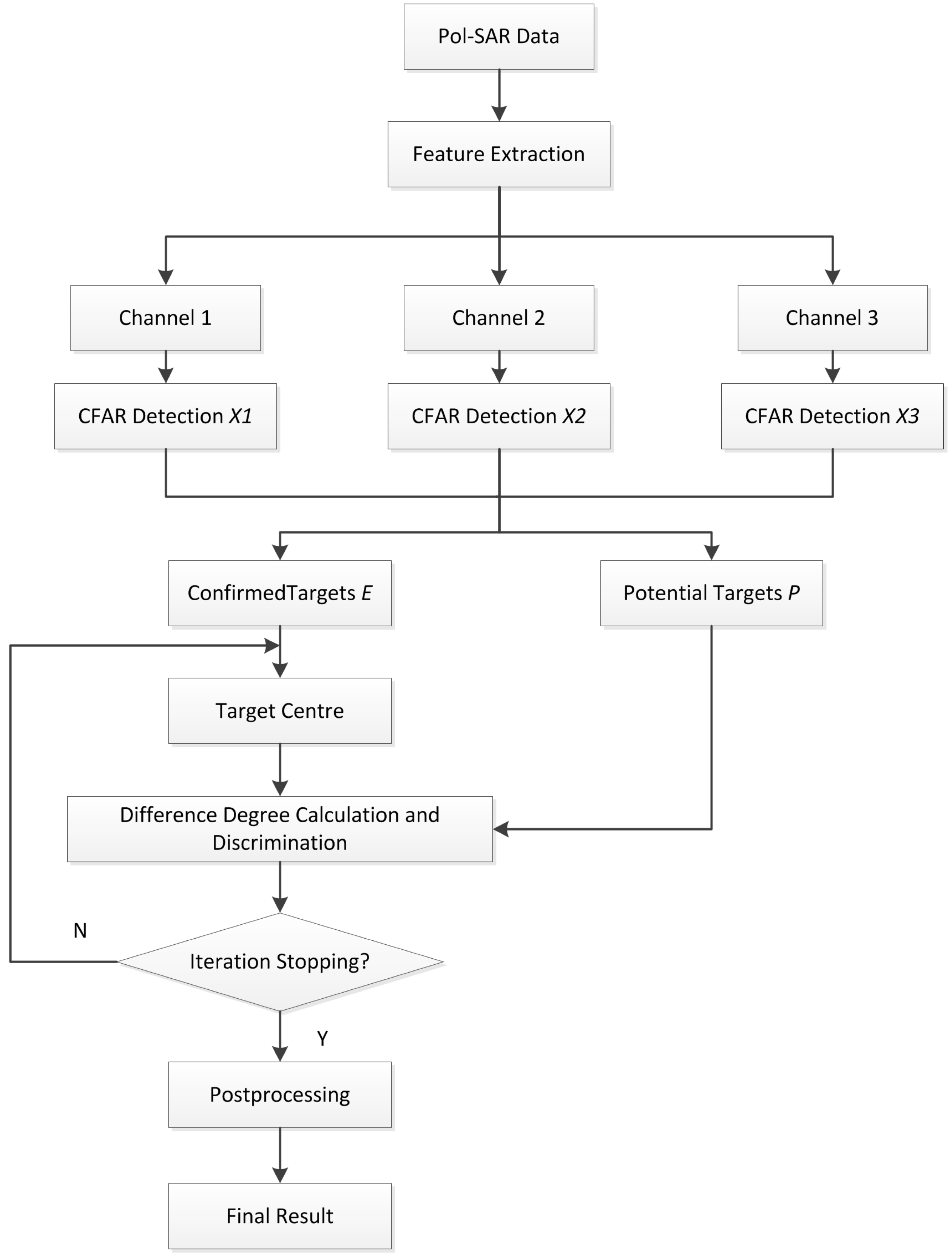
3.1. Feature Extraction
3.2. CFAR Detection

3.3. Fusion Processing
3.4. Potential Target Pixels Judgment
4. Experimental Verification
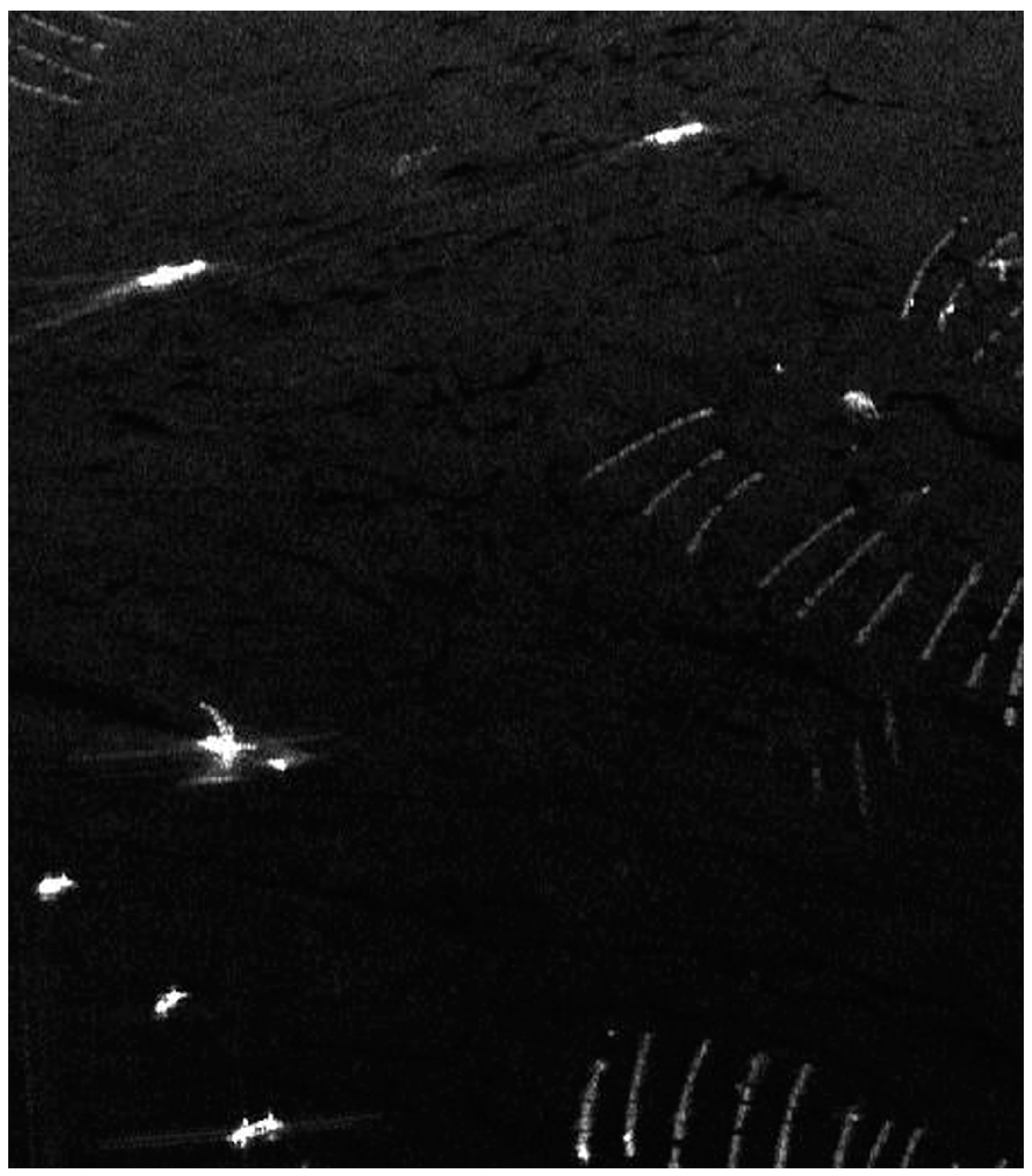
4.1. Ship Detection Performance
4.1.1. Fusion-Based Ship Detection



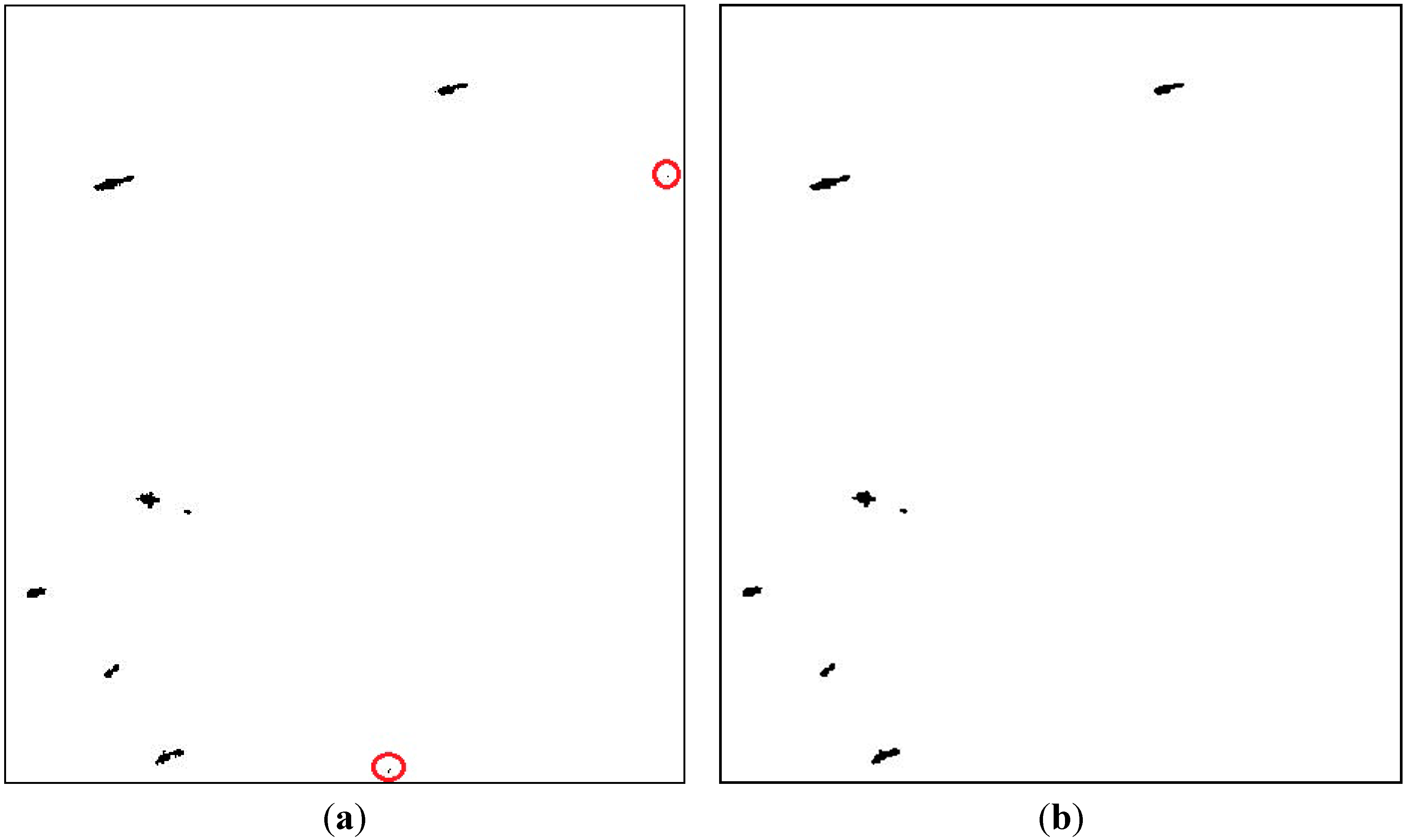
4.1.2. Ship Detection Based on K-means Clustering

4.1.3. Ship Detection Based on Notch Filter

4.2. Target Shape Preserving
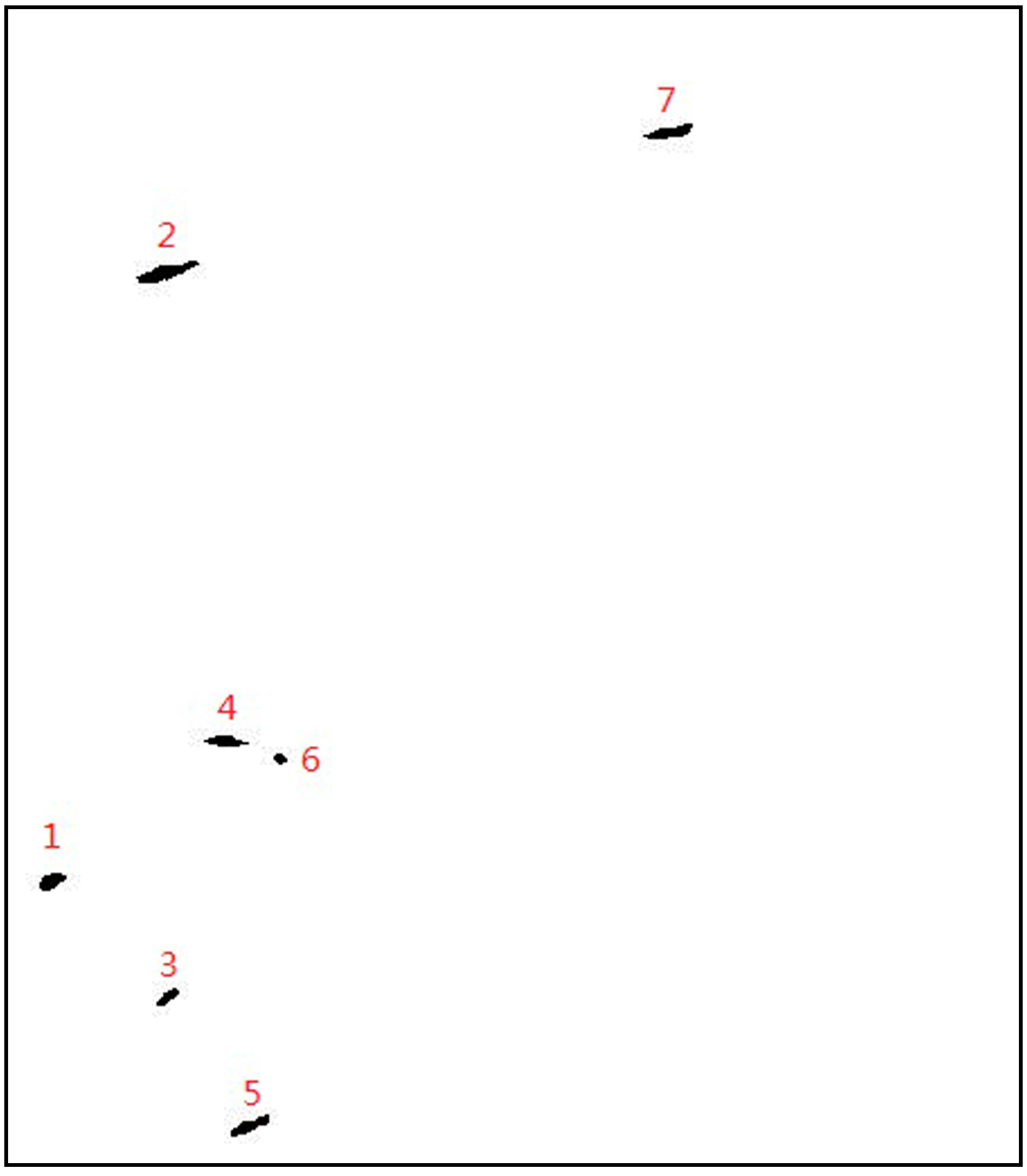
| Ship No. | Nmodel | K-Means Clustering | The Notch Filter | Fusion-Based Method | |||||||||
|---|---|---|---|---|---|---|---|---|---|---|---|---|---|
| Ndet | Ncor | Nfal | Nmiss | Ndet | Ncor | Nfal | Nmiss | Ndet | Ncor | Nfal | Nmiss | ||
| 1 | 64 | 93 | 62 | 29 | 2 | 176 | 64 | 112 | 0 | 70 | 57 | 6 | 7 |
| 2 | 128 | 191 | 102 | 63 | 26 | 518 | 128 | 390 | 0 | 136 | 116 | 8 | 12 |
| 3 | 40 | 75 | 40 | 35 | 0 | 144 | 40 | 104 | 0 | 50 | 35 | 10 | 5 |
| 4 | 65 | 140 | 56 | 75 | 9 | 473 | 65 | 408 | 0 | 101 | 53 | 36 | 12 |
| 5 | 75 | 145 | 65 | 70 | 10 | 266 | 75 | 191 | 0 | 99 | 71 | 24 | 4 |
| 6 | 21 | 38 | 18 | 17 | 3 | 102 | 21 | 81 | 0 | 22 | 10 | 1 | 11 |
| 7 | 85 | 114 | 69 | 29 | 16 | 304 | 85 | 219 | 0 | 103 | 66 | 18 | 19 |
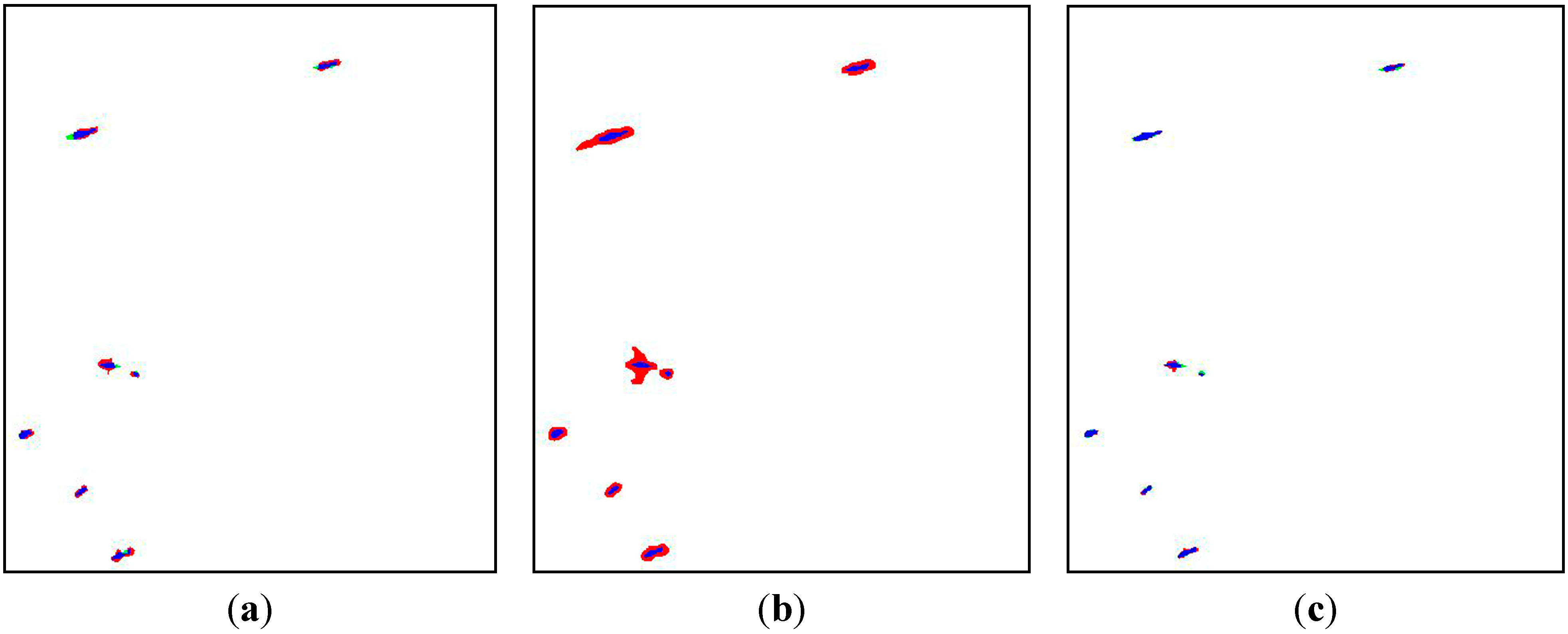
| Ship No. | K-Means Clustering | The Notch Filter | Fusion-Based Method |
|---|---|---|---|
| 1 | 66.7 | 36.4 | 81.4 |
| 2 | 53.4 | 24.7 | 85.3 |
| 3 | 53.3 | 27.8 | 70.0 |
| 4 | 40.0 | 13.7 | 52.5 |
| 5 | 44.8 | 28.2 | 71.7 |
| 6 | 47.4 | 20.6 | 45.5 |
| 7 | 60.5 | 28.0 | 64.1 |
| Average | 51.8 | 24.1 | 70.2 |
5. Conclusions
Acknowledgments
Author Contributions
Conflicts of Interest
References
- Copeland, A.C.; Ravichan, G.; Trivedi, M.M. Localized radon transform-based detection of ship wakes in SAR Images. IEEE Trans. Geosci. Remote Sens. 1995, 33, 35–45. [Google Scholar] [CrossRef]
- Vachon, P.W.; Campbell, J.; Bjerklund, C. Ship detection by the RADARSAT SAR: Validation of detection model predictions. Can. J. Remote Sens. 1997, 23, 48–59. [Google Scholar] [CrossRef]
- Liu, C.; Vachon, P.W.; Geling, G.W. Improved ship detection with airborne polarimetric SAR data. Can. J. Remote Sens. 2005, 31, 122–131. [Google Scholar] [CrossRef]
- Touzi, R.; Charbonneau, F.; Hawkins, R.K.; Murnaghan, K.; Kavoun, X. Ship-sea contrast optimization when using polarimetric SARs. In Proceedings of the IGARSS’ 01, Sydney, Australia, 9–13 July 2001; pp. 426–428.
- Ringrose, R.; Harris, N. Ship detection using polarimetric SAR data. In Proceedings of the CEOS SAR workshop, Toulouse, France, 26–29 October 1999; pp. 687–691.
- Cameron, W.L.; Youssef, N.N.; Leung, L.K. Simulated polarimetric signatures of primitive geometrical shapes. IEEE Trans. Geosci. Remote Sens. 1996, 34, 793–803. [Google Scholar] [CrossRef]
- Touzi, R. Characterization of target symmetric scattering using polarimetric SARs. IEEE Trans. Geosci. Remote Sens. 2002, 40, 2507–2516. [Google Scholar] [CrossRef]
- Nunziata, F.; Migliaccio, M.; Brown, C.E. Reflection symmetry for polarimetric observation of man-made metallic targets at sea. IEEE J. Ocean. Eng. 2012, 37, 384–394. [Google Scholar] [CrossRef]
- Nunziata, F.; Migliaccio, M. On the COSMO-SkyMed PingPong Mode to observe metallic targets at sea. IEEE J. Ocean. Eng. 2013, 38, 71–79. [Google Scholar] [CrossRef]
- Yeremy, M.; Campbell, J.W.M.; Mattar, K.; Potter, T. Ocean surveillance with polarimetric SAR. Can. J. Remote Sens. 2001, 27, 328–344. [Google Scholar] [CrossRef]
- Li, H.Y.; He, Y.J.; Wang, W.G. Improving ship detection with polarimetric SAR based on 2-D convolution between co-polarization channels. Sensors 2009, 9, 1221–1236. [Google Scholar] [CrossRef] [PubMed]
- Wang, W.G.; Wang, J.; Lei, P.; Mao, S.Y. A new ship detection method based on polarimetric SAR classification. Chin. J. Electron. 2008, 17, 769–774. [Google Scholar]
- Marino, A. A notch filter for ship detection with polarimetric SAR data. IEEE J. Sel. Top. Appl. Earth Obs. Remote Sens. 2013, 6, 1219–1232. [Google Scholar] [CrossRef]
- Marino, A.; Hajnsek, I. Statistical tests for a ship detector based on the Polarimetric Notch Filter. IEEE Trans. Geosci. Remote Sens. 2015, 53, 4578–4595. [Google Scholar] [CrossRef]
- Velotto, D.; Soccorsi, M.; Lehner, S. Azimuth ambiguities removal for ship detection using full polarimetric X-Band SAR data. IEEE Trans. Geosci. Remote Sens. 2014, 52, 76–88. [Google Scholar] [CrossRef]
- Migliaccio, M.; Nunziata, F.; Montuori, A.; Li, X.; Pichel, W.G. A multifrequency polarimetric SAR processing chain to observe oil fields in the Gulf of Mexico. IEEE Trans. Geosci. Remote Sens. 2011, 49, 4729–4737. [Google Scholar] [CrossRef]
- Polarimetry Tutorial Part 1-Tutorial on Radar Polarimetry: Polarimetric Decomposition. Available online: https://earth.esa.int/web/polsarpro/polarimetry-tutorial (accessed on 2 July 2015).
- Wang, W.G.; Wang, J.; Mao, S.Y. Classification of polarimetric SAR images based on difference degree. In Proceedings of the EUSAR, Dresden, Germany, 16–18 May 2006.
- Lu, F.; Wang, W.G.; Xing, K.Q.; Lin, X.X. The ship discrimination based on D-S evidence theory. In Proceedings of the 11th International Conference on Signal Processing, Beijing, China, 21–25 October 2012; pp. 1896–1899.
© 2015 by the authors; licensee MDPI, Basel, Switzerland. This article is an open access article distributed under the terms and conditions of the Creative Commons Attribution license (http://creativecommons.org/licenses/by/4.0/).
Share and Cite
Wang, W.; Ji, Y.; Lin, X. A Novel Fusion-Based Ship Detection Method from Pol-SAR Images. Sensors 2015, 15, 25072-25089. https://doi.org/10.3390/s151025072
Wang W, Ji Y, Lin X. A Novel Fusion-Based Ship Detection Method from Pol-SAR Images. Sensors. 2015; 15(10):25072-25089. https://doi.org/10.3390/s151025072
Chicago/Turabian StyleWang, Wenguang, Yu Ji, and Xiaoxia Lin. 2015. "A Novel Fusion-Based Ship Detection Method from Pol-SAR Images" Sensors 15, no. 10: 25072-25089. https://doi.org/10.3390/s151025072





